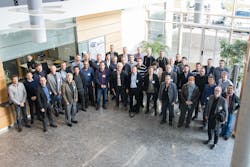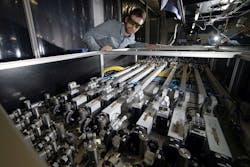Market Insights: Workshop on next-generation optical fiber technology provides perspectives and a roadmap
Fiber lasers have been pivotal for the development of advanced manufacturing, medical diagnostics and procedures, and communications, along with applied sciences and, potentially, the next generation of business opportunities. To meet these challenges, there are more than 50 independent R&D groups working worldwide to develop new optical fiber technologies.
From November 12-14, 2017, some 50 of these fiber technology experts gathered in Jena, Germany, to coordinate their views on prospects, market needs, and requirements for optical fiber technologies, and to develop the first steps toward a strategic and harmonized optical fiber technology roadmap (see Fig. 1). The three-day Next generation fiber technology—perspectives and roadmap workshop was a joint event of the Institute for Applied Physics of the Friedrich Schiller University Jena and the Fraunhofer Institute for Applied Optics and Precision Engineering IOF. It was arranged within funded European Research Council (ERC) Advanced Grant project MIMAS (Multi-dimensional interferometric amplification of ultrashort laser pulses; https://goo.gl/ttAfbE).
Market needs and requirements
The workshop began with four presentations of experts in the fields of life science, production and materials processing, fundamental research, and information technology. These plenary speakers pointed out science cases and challenges in their areas of business or research and defined the demands on future fiber technology needed to enable, stimulate, or even boost existing or emerging markets.
The main demands for fiber technology in these fields can be summarized as follows:
Industrial fiber lasers rely on reliability and reproducibility; hence, multiple sources for degradation-free advanced amplifying and delivery fibers must exist in the future. Multi-core technologies, including multi-mode Joule-class transport fibers, with the ability to guide high peak energies without nonlinear effects and photodarkening will be key technologies.
Telecommunications will require fiber structures that allow for higher data transmission rates. Thus, new amplifier concepts with extended low loss will lead to increasing bandwidth. Multi-core and multi-mode fibers as well as new transmission windows in the two-micrometer wavelength range ensure more information channels and increasing overall fiber capacity.
Fundamental science will require fiber technology able to deliver visionary laser parameters that are orders of magnitude beyond the current state-of-the-art.
Life sciences will greatly benefit from optical fibers with an extended wavelength diversity and reliable process technology.
The participants split into four sub-workshops to discuss the technological advances needed to tackle the questions and challenges raised by the plenary speakers. The sub-workshops focused on: theory & fiber design, fiber materials, fiber technology & manufacturing, and fiber laser system integration.
The main result of these discussions is a roadmap summarizing the envisioned technological steps on a short-, mid-, and long-term scale that must be taken to develop optical fiber technology in the directions required to address the demands detailed by the plenary speakers.
Technological roadmap
The main steps of the roadmap were developed as follows:
The Theory & Fiber Design sub-workshop focused on new developments in fiber technology such as effective mitigation strategies for transverse mode instabilities, new fiber designs for high-power large-mode-area fibers, bendable large core fibers and advanced dispersion control, new hollow core fibers with extended functionality such as polarization control, and multicore fibers for higher power or data transmission.
The Fiber Materials sub-workshop highlighted the need for degradation-free active as well as passive fibers, new concepts for controlling the homogeneity of dopants and refractive index in both the core and cladding material, fabrication methods for large volumes of active and passive optical material with reduced cost and enhanced reliability, fiber and coating materials for harsh environments, low-loss materials in non-standard wavelength regions such as UV and mid-IR and crystalline waveguide structures for reaching the highest power levels in the future.
The Fiber Technology & Manufacturing sub-workshop discussed new fabrication concepts for multicore fibers with very high channel counts, the fabrication and packaging of long lengths and low loss beam delivery fibers (>10 kW over 10 km), fibers for frequency conversion, and concepts for dynamic beam shaping within either the active or the delivery fiber. Beyond that, the need for a fiber architecture allowing for 10 kW emission with diffraction-limited beam quality was emphasized.
The Fiber System Integration sub-workshop stressed the need for cost-effective combiners and connectors with high-power handling capability, as well as the integration of functionality in the fibers in the form of sensors, mode adapters, beam shaping elements, spectral filters, and integrated phase modulators.Furthermore, concepts for massive fiber parallelization followed by a subsequent beam combination stage, were discussed as a means to address the most demanding applications in science such as laser-driven particle acceleration (see Fig. 2).
More insights into the identified needs and a broader and detailed view of the harmonized technological roadmap will be presented and published at SPIE Photonics West 2018.

Andreas Thoss | Contributing Editor, Germany
Andreas Thoss is the Managing Director of THOSS Media (Berlin) and has many years of experience in photonics-related research, publishing, marketing, and public relations. He worked with John Wiley & Sons until 2010, when he founded THOSS Media. In 2012, he founded the scientific journal Advanced Optical Technologies. His university research focused on ultrashort and ultra-intense laser pulses, and he holds several patents.
Jens Limpert | Professor for Physics, Department of Fiber & Waveguide Lasers at Friedrich Schiller University
Jens Limpert is Professor for Physics and leads the department of Fiber & Waveguide Lasers at Friedrich Schiller University (Jena, Germany).
Kevin Füchsel | Head of Department Strategy & Marketing, Fraunhofer IOF
Kevin Füchsel is head of department strategy & marketing at the Fraunhofer Institute for Applied Optics and Precision Engineering (Fraunhofer IOF; Jena, Germany).
Thomas Schreiber | Group Leader, Fiber Laser Research at Fraunhofer IOF
Thomas Schreiber is group leader for fiber laser research at the Fraunhofer Institute for Applied Optics and Precision Engineering (Fraunhofer IOF; Jena, Germany).
Andreas Tünnermann
Andreas Tünnermann is director of the Fraunhofer Institute for Applied Optics and Precision Engineering (Fraunhofer IOF), as well as a professor in physics and director of the Institute of Applied Physics at Friedrich Schiller University (both in Jena, Germany).

